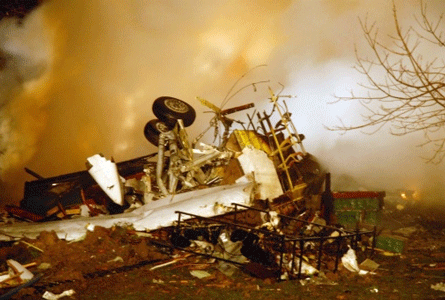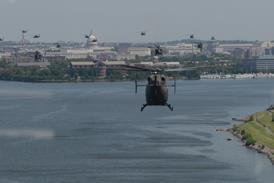Julian Moxon/BASLE
YOU ARE THE OWNER of a corporate jet, and you want the ultimate in airborne opulence. Perhaps, if you are also the owner of a golf course, you would like a game of "mini-golf" included in the carpet design, or, if you are an Arab Sheik, gold-plated fittings throughout the cabin, with a conference seating area decorated with the finest silks.
Only a few companies can provide such a service, which must be coupled not only with quality and timeliness, but also extreme discretion. One such is Jet Aviation, which recently completed the Boeing 737-200 conversion pictured, and is preparing to carry out similar work on even larger aircraft in the near future.
Despite its prestige nature, this is but a small portion of Jet Aviation's business, for this is the world's largest business-aviation service company.
GROWTH OVER 30 YEARS
Founded in 1967 by entrepreneur Carl Hirschmann as an addition to an already vast and diverse business empire, the company now employs 1,700 people, with customers in 25 locations worldwide, and has 130 aircraft in its fleet of managed and owned aircraft.
Hirschmann died in April, leaving his son, Thomas, to run the business. Originally, Jet Aviation was based in Zurich and Geneva, Switzerland, where, in 1969, it took over the maintenance and handling for Pilatus Aircraft. By 1975, the company had expanded into Germany, where it began to develop its reputation for customised interior-aircraft design. This led to a deal with a group of Saudi Arabian businessmen in 1979, providing corporate-aircraft handling at Jeddah, and helping to secure Jet Aviation's niche market in cabin outfitting.
Next came the inevitable move to the USA in 1982, and the purchase of several fixed-base operations, leading ultimately to the acquisition of the largest management and charter company in the USA, Executive Air Fleet, based at Teterboro, New Jersey. In 1991, Jet Aviation moved to West Palm Beach, Florida.
Maintenance accounts for almost 50% of Jet Aviation's revenue, while aircraft management and air-taxi operations account for around 20%, with handling earning a further 20%, the rest stemming from aircraft-charter operations.
The company has recently entered the field of fractional ownership, offering members of the Geneva-based "Corpavia Club" a share of Raytheon Beechjet 400As. Jet Aviation has placed orders for two aircraft, with options on a further ten, but is biding its time before claiming the kind of success which others in the same field appear to be doing. "We're taking it slow and steady", says business jet vice-president and general manager Theo Staub.
Jet Aviation's main activity is aircraft management, in which, Staub notes, "...business is relatively stable, although there is still significant growth in the Middle East. We also think there is big potential for growth in the Far East." The company has recently announced its expansion to Singapore. It expects to begin charter operations in Japan, Malaysia, Singapore and South Korea soon, and hopes to do the same in India.
The company operates the largest owned fleet of corporate and private jets and helicopters in the world, with 130 aircraft in the USA, Europe, the Middle East and Pacific Rim. The business takes care of all of the services necessary for managing and operating a customer's aircraft, including providing the crew, insurance, carrying out despatch formalities, and maintenance. "In other words, we take away the hassle of ownership," says Staub. "The owner enjoys the prestige that ownership brings, but he leaves all the intricate operational details to us."
Jet Aviation will also help with new-aircraft financing, and take care of legal questions. Staub says that the cost to the owner can be less than if he attempts to manage the aircraft himself, since Jet Aviation can take advantage of economies of scale in, for example, ground handling, fuel, crew-training expenses and insurance. "We reckon that it works best for a customer who flies his aircraft for less than 500h per year", he says.
REDUCED FIXED COSTS
The fixed costs of ownership can also be reduced through a scheme whereby the aircraft is leased out for air-taxi operations while the owner is not using it. The way this works depends on the kind of flight-support agreement signed with the owner.
Ownership trends are towards larger, longer-range aircraft, says Staub, adding that "we are confident that some of our customers will change to the Bombardier Global Express and Gulfstream GV".
Air-taxi operations cover the provision of aircraft from the Cessna Citation II-size class up to the Boeing 727 and McDonnell Douglas DC-8-72. Jet Aviation also has three of its own aircraft, a Challenger 600 and two Citation IIs, "...but we need managed aircraft. You can't survive in this business on owned aircraft alone", says Staub.
A visit to the aircraft-maintenance centre in Basle is an eye-opening reminder that the corporate-aircraft business is where the ultimate in aircraft care is found. The hangar gleams with reflected light from highly polished aluminum wings and engine inlets, the aircraft being given the special attention that only large amounts of money can buy. At the time of Flight International's visit, a new hangar extension had just been completed, enabling the Basle centre to accommodate aircraft up to Boeing 747 size.
The company has factory-approved service centres around the world, having recently gained the first European maintenance warranty for the Dassault Falcon. At Teterboro it maintains 30 managed aircraft based at the airport, as well as carrying out heavy maintenance, mainly for Falcon Jets, Jet Aviation having acquired the Falcon Jet maintenance operation in 1992.
The most glamorous end of the business is without doubt, that of aircraft outfitting and, at Basle, business has seen an "explosion" in growth over the last 18 months, says interior designer Francis Munch. The company is now working on its second Boeing 737 conversion (this is the one with the "mini-golf" carpet design), the "green" aircraft having been purchased direct from Boeing.
"We got a strong feeling at this year's National Business Aircraft Association meeting that the market for conversions was picking up," says Munch. There seems to be no limit to the size of aircraft, either. "We've done 707s, DC-8s, 727s and 737s," he adds, "but we don't think it will be long before we're converting wide bodies."
An example of the challenge an executive conversion can pose is the Boeing 737-200 pictured. "We took a 124-seat aircraft that had been in airline service in near Arctic conditions," says engineering manager Georg Worlein, "and converted it to a VIP transport accommodating 27 passengers in a very hot climate." This involved stripping out the entire aircraft interior aft of the cockpit, installation of a long-range fuel tank below the cabin floor, and assembly of the wooden bulkheads and cabinets in one of the Basle workshops to ensure that everything fitted together perfectly.
To guarantee the kind of soundproofing which the owner of such an interior would naturally expect (Jet Aviation refrains from disclosing the names of such customers), the entire internal cabin shell, consisting of a stateroom, a three-lounge main cabin and a mid-cabin toilet, was mounted on sound-absorbing shock absorbers. On top of this, says Munch, "...we installed more soundproofing material in the cabin than any of us have ever seen on an aircraft".
Each lounge is adorned with lavish artwork, including engravings and gold-plating, and most of the metallic devices in the cabin are also gold- plated. "Over 20kg of gold was used throughout the interior," says Munch. The project took around 60,000h of labour to complete, including some 10,000h for the design, which was carried out by Dallas, Texas-based Aviation Concepts.
Outfitting to this standard is more akin to equipping a high-class yacht than an aircraft, and includes some unusual requirements, such as flying the carpenter at operating altitude to deal with any deformations that may occur in fitted furniture because of the cabin-pressure changes. In a large aircraft this can mean a change of several centimetres in the fuselage's circumference.
Europe is the best place to carry out such high-quality work, says Munch, since it is placed between the USA and Middle East, from where most of the contracts originate. Jet Aviation also benefits from its Swiss heritage, with its reputation for precision engineering and discrete services.
Hirschmann's legacy is clearly intact, as is the philosophy with which the company is run. Quality of service and competitiveness are at its heart, but also a protectiveness, often associated with privately owned companies. Financial performance, for example, is not disclosed, apart from the Jet Aviation group turnover - SFr365 million ($265 million) in 1994 - and net income (SFr 10.3 million), which is about the same as for 1993. Staub makes one financial fact clear, however. "We're always in profit", he says.
Source: Flight International























